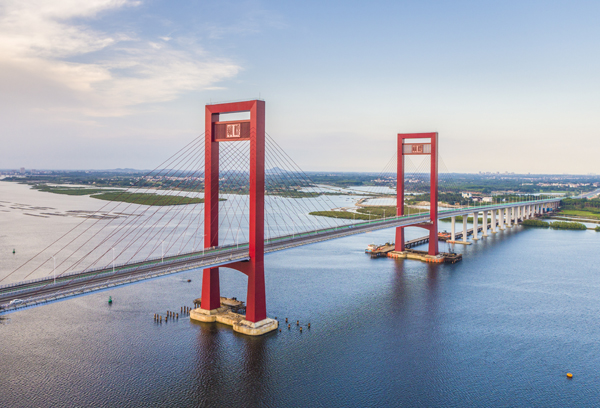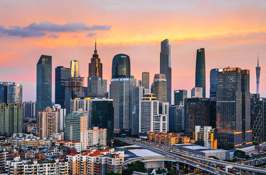Air, land and marine transport upgraded after major expansion
The Wuchuan section of the Shantou-Zhanjiang Expressway opened to traffic in Zhanjiang on Tuesday.
It is planned to connect to the Zhanjiang Airport Expressway, which is under construction, and to Maoming city in Guangdong province.
On the previous day, the Tiaoshun cross-sea bridge went into service, connecting eastern and western parts of Zhanjiang and improving the traffic efficiency between the Haidong New Area and downtown Zhanjiang.
Several more expressways are set to open in the near future. They include the Donghai Island-Leizhou Expressway, Zhanjiang's first intracity expressway, which extends more than 21.94 kilometers.
In early June, the 400,000-metric-ton ore carrier Ore Zhanjiang docked in Zhanjiang Port, marking the port as the first deepwater port in South China with the capability to berth 400,000-ton vessels.
"Our city has kept spending on improving its transportation system to consolidate the position as a national comprehensive transport hub and to ensure high-quality economic and social development with rapid transport development," said Zeng Jinze, mayor of Zhanjiang, during the opening ceremony of the Tiaoshun bridge on Monday.

The Tiaoshun cross-sea bridge is put into service in Zhanjiang on Monday. ZHANG FENGFENG/FOR CHINA DAILY
The city made fixed asset investments in transport exceeding 70 billion yuan ($10.82 billion) during the 13th Five-Year Plan (2016-20), official statistics indicate.
Thanks to the hefty investment, Zhanjiang boasts a transport system involving the sea, railways, highways and aviation. It was even included in an overall plan for western land and sea transportation released by the National Development and Reform Commission in 2019.
The city's modern transportation system is represented by such infrastructure as Zhanjiang Wuchuan Airport, five high-speed railway lines and a maritime channel that can hold 400,000-ton ships.
Zhanjiang's length of highways reached 22,400 km by the end of 2020, ranking second in Guangdong. Expressway length, meanwhile, hit 414.93 km.
The city will start the construction on 15 highway projects and promote preliminary work on the Zhanjiang section of the Guangdong coastal sightseeing roads during the 14th Five-Year Plan (2021-25).
The Guangzhou-Zhanjiang high-speed railway, which can allow trains to go 350 km per hour, has begun construction. Preliminary work on other high-speed railways running through Zhanjiang are advancing. They include one connecting the city to Haikou, capital of southernmost island province of Hainan.
An intercity train project, involving Zhanjiang, Maoming and Yangjiang, is being planned and transportation between Zhanjiang and southwestern regions is expected to improve in the near future, local media reported.
The world's largest passenger-cargo roll-on roll-off wharf came into operation in the Xuwen port area in September 2020, which increased navigation efficiency in the Qiongzhou Strait, local media reported at the time.
With the deepwater port and wharf operating, Zhanjiang plans to develop itself into a port-type logistics hub.
Zhanjiang Wuchuan Airport is scheduled to complete construction this year and open to air traffic next year. Its supporting facilities, including the airport expressway and the airport section of the Shenzhen-Zhanjiang Railway, are also under construction.
The new airport is designed for a yearly throughput of 5.1 million passengers. It will be capable of handling 31,000 tons of cargo and 47,400 aircraft arrivals and departures annually.
Official data showed fixed investments in Zhanjiang's road transport industry amounted to 2.04 billion yuan in first four months of this year, a year-on-year rise of 27.9 percent.
Guan Yu, chief economist at the Zhanjiang industry and information technology bureau, said better transport infrastructure will shorten the time and distance between Zhanjiang and the Pearl River Delta and help the city to better integrate into the Guangdong-Hong Kong-Macao Greater Bay Area.



 Print
Print Mail
Mail

